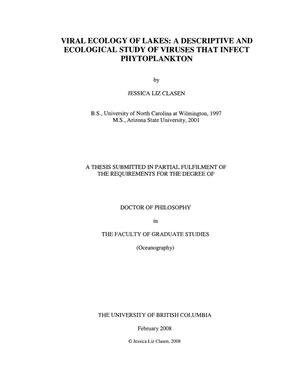Suttle, Curtis A.
Person Preferred Name
Curtis A. Suttle
Related Works
Content type
Digital Document
Abstract
Since the 'discovery' of the high abundance of viruses in aquatic environments, it has been generally assumed that viruses in lakes are similar to those in oceans. I directly compared these two systems using a large, robust data set. Viral abundance was significantly different among the surveyed environments. The relationship between viral and bacterial abundance indicated a fundamental difference between lakes and oceans, and suggested that viruses infecting phytoplankton may be more important in lakes. Molecular techniques (PCR & DGGE) were used to document spatial and temporal variations in the richness of viruses that infect eukaryotic phytoplankton (Phycodnaviridae) in lakes at the Experimental Lakes Area (ELA). Phycodnavirus richness was highest in the eutrophic lake, and during the spring/early summer in all the lakes. Viral richness was closely associated with phytoplankton abundance and composition. As a result, richness was influenced by trophic status, while patterns of richness were affected by regional climatic conditions. Phylogenetic analysis of environmental Phycodnavirus DNA polymerase (pol) sequences indicated that freshwater Phycodnaviruses are genetically different from cultured isolates and marine environmental sequences. A genetic distance analysis indicated that pol sequences > 7 % different infected different host species. Therefore, the 20 different freshwater sequences likely infected nine different hosts. Multivariate statistics identified seven possible phytoplankton hosts, including chlorophytes, chrysophytes, diatoms and dinoflagellates. Finally, the modified dilution experiment was evaluated as an approach for estimating viral-mediated phytoplankton mortality in two lakes at the ELA. Experiments resulted in non-significant apparent growth rate regressions. While a model analysis, indicated that the method was sensitive to poorly constrained parameters such as burst size and length of the lytic cycle, making it unsuitable for estimating mortality rates in these lakes. These studies indicate that Phycodnaviridae are a genetically rich and dynamic component of lakes. Their richness is influenced by both the chemical and physical components of their environment. Although the presence of these viruses indicates that they are a source of phytoplankton mortality, the magnitude of their impact on structuring phytoplankton communities awaits methodological advances. Nonetheless, these findings support the view that viruses infecting phytoplankton are ecologically important components of lake ecosystems.
Origin Information
Content type
Digital Document
Abstract
1. Samples from 16 lakes in central ( n = 145) and western ( n = 12) North America, the coastal northeast Pacific ( n = 302) and the western Canadian Arctic Oceans ( n = 142) were collected and analysed for viral, bacterial and cyanobacterial abundances and chlorophyll- a concentration. 2. Viral abundance was significantly different among the environments. It was highest in the coastal Pacific Ocean and lowest in the coastal Arctic Ocean. The abundances of bacteria and cyanobacteria as well as chlorophyll- a concentrations also differed significantly among the environments, with both bacterial abundance and chlorophyll- a concentration highest in lakes. As a consequence, the association of these variables with viral abundance varied among the environments. 3. Discriminant analyses with the abundance data indicated that the marine and freshwater environments were predictably different from each other. Multiple-regression analysis included bacterial and cyanobacterial abundances, and chlorophyll- a concentration as significant variables in explaining viral abundance in lakes. In regression models for the coastal Pacific Ocean, bacterial and cyanobacterial abundances were significant variables, and for the coastal Arctic Ocean viral abundance was predicted by bacterial abundance and chlorophyll- a concentration. 4. The relationship of viral and bacterial abundance differed between the investigated freshwater and marine environments, probably because of differences in viral production and loss rates. However, freshwaters had fewer viruses compared to bacteria, despite previously documented higher burst sizes and frequencies of infected cells, suggesting that loss rates may be more important in lakes. 5. Together, these findings suggest that there are different drivers of viral abundance in different aquatic environments, including lakes and oceans. [ABSTRACT FROM AUTHOR]
Origin Information
Content type
Digital Document
Abstract
The book chapter, "Isolation independent methods of characterizing phage communities 1: Strain typing using fingerprinting methods" was written by authors: Jessica L. Clasen (Douglas College Faculty) and is located in the book "Bacteriophages. Methods and Protocols (which is volume 2 of the Molecular and Applied Aspects book series). Since most of the phage genomes isolated from natural samples are previously unknown sequences, an isolation-independent approach is necessary to quantify the diversity of natural viral communities. Currently, two different methodological approaches are widely used to obtain genetic fingerprints of natural phage communities. While the separation of different viral genomes with pulsed field gel electrophoresis (PFGE) is based on the size of the genome, denaturing gradient gel electrophoresis (DGGE) uses minor differences in gene base composition to separate fragments of amplified DNA from natural viral communities. Finger printing techniques are a relatively fast and cheap tool to assess the diversity of environmental viruses. Together, PFGE and DGGE provide useful tools to study viral ecology in natural habitats.
Origin Information
Content type
Digital Document
Abstract
Viruses that infect phytoplankton are an important component of aquatic ecosystems, yet in lakes they remain largely unstudied. In order to investigate viruses (Phycodnaviridae) infecting eukaryotic phytoplankton in lakes and to estimate the number of potential host species, samples were collected from four lakes at the Experimental Lakes Area in Ontario, Canada, during the ice-free period (mid-May to mid-October) of 2004. From each lake, Phycodnaviridae DNA polymerase (pol) gene fragments were amplified using algal-virus-specific primers and separated by denaturing gradient gel electrophoresis; 20 bands were extracted from the gels and sequenced. Phylogenetic analysis indicated that freshwater environmental phycodnavirus sequences belong to distinct phylogenetic groups. An analysis of the genetic distances "within" and "between" monophyletic groups of phycodnavirus isolates indicated that DNA pol sequences that differed by more than 7% at the inferred amino acid level were from viruses that infect different host species. Application of this threshold to phylogenies of environmental sequences indicated that the DNA pol sequences from these lakes came from viruses that infect at least nine different phytoplankton species. A multivariate statistical analysis suggested that potential freshwater hosts included Mallomonas sp., Monoraphidium sp., and Cyclotella sp. This approach should help to unravel the relationships between viruses in the environment and the phytoplankton hosts they infect.
Origin Information



